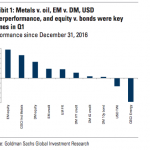The Eurozone economy faces several question marks in the fourth quarter. Weak growth, an escalating banking crisis and an upcoming referendum in Italy are just some of the challenges gripping the currency region. Surprisingly, the euro has held up relatively steady for most of the year, at least until recently. The EUR/USD has declined 2.5% over the past four weeks, as investors rallied behind the dollar on growing signs the Federal Reserve will raise interest rates by the end of the year. For traders of the euro, November is a critical month on the economic calendar. Below is a list of high-profile market releases that could impact European financial assets.
November 3: Eurozone Unemployment Rate (September)
Unemployment is one of the most closely followed indicators in the financial markets. Eurozone unemployment has been gradually declining over the years, but remains above 10%. This is unlikely to change in September.
November 4: Eurozone Producer Price Index (September)
The consumer price index (CPI) isn’t the only form of inflation traders monitor. The producer price index (PPI) measures the prices paid in primary markets. Producer price inflation have shown signs of recovery this year, but have been inconsistent.
November 7: Eurozone Retail Sales (September)
Retail sales are an important proxy of consumer spending in the economy. Sales slipped 0.1% in August, but were up 0.6% compared to year ago levels. Traders bullish on the euro usually look for a high retail sales reading.
November 8: Germany Industrial Production, Trade Balance (September)
Germany is not only Europe’s largest economy, it’s also the region’s foremost industrial centre. On November 8, the Federal Statistics Office will report on industrial production and trade, two key measures of the German economy.
November 11: Germany Consumer Price Index (October)
The German government will release its final estimate of October consumer inflation on November 11. This includes both the consumer price index (CPI) and the harmonized index of consumer prices (HICP).











Leave A Comment